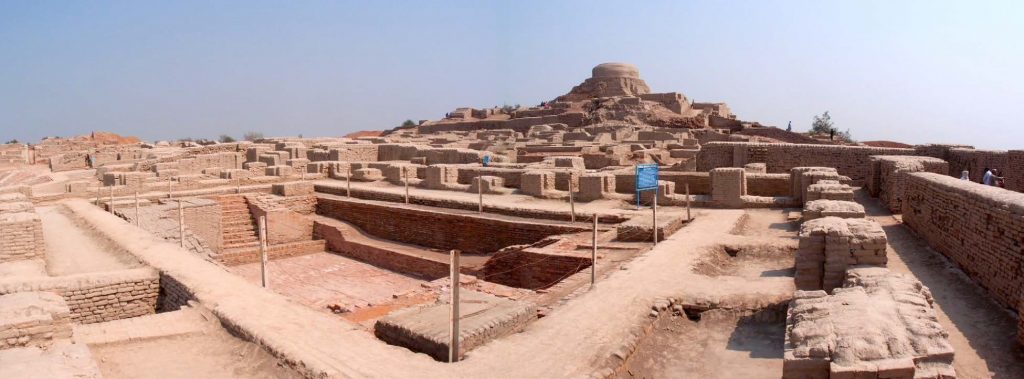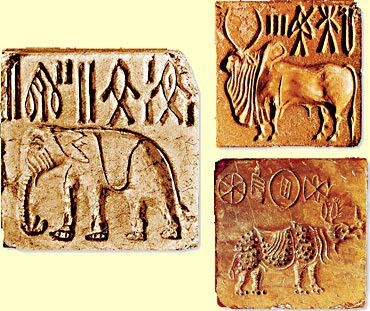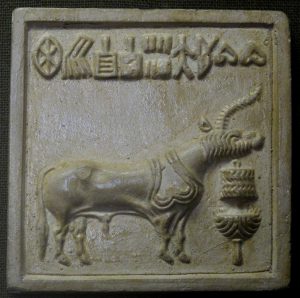India’s First Major Civilization: The Indus Valley Civilization (2600 BCE – 1700 BCE)
A century of archaeological work in India that began in 1920 not only revealed a lost civilization but also a massive one, surpassing in size other major early riverine civilizations of Afro-Eurasia, such as ancient Egypt and the Mesopotamian states. In an area spanning roughly a half million square miles, archaeologists have excavated thousands of settlements (see Map 3.2). These can be envisioned in a hierarchy based on size and sophistication. The top consists of five major cities of roughly 250 acres each. One of those is Harappa, and because it was excavated first the entire civilization was named Harappan Civilization. The bottom of the hierarchy consists of fifteen thousand smaller agricultural and craft villages of about 2.5 acres each, while between the top and bottom lie two tiers with several dozen towns ranging in size from 15 to 150 acres. Because the majority of these settlements were situated near the Indus River in the northwestern region of the subcontinent, this civilization is also called the Indus Valley Civilization.
As with ancient Egypt and Mesopotamia, archaeologists have been able to sketch out how this civilization evolved out of the simpler agricultural villages of the Neolithic period. On the subcontinent, farming and the domestication of animals began c. 7000 BCE, about two thousand years after they did in the Fertile Crescent. To the west of the Indus River, along the foothills of Baluchistan, the remains of numerous small villages have been found that date back to this time (see Map 3.3). One of these is Mehrgarh. Here, villagers lived in simple mud-brick structures, grew barley and wheat, and raised cattle, sheep, and goats.
Over the course of the next three thousand years, similar Neolithic communities sprang up not only in northwest India but also in many other locations on the subcontinent. But it was to the west of the Indus River and then throughout neighboring fertile plains and valleys of the Punjab and Sindh that we see the transition to a more complex, urban-based civilization. Excavations throughout this region show a pattern of development whereby settlements start looking more like towns than villages: ground plans become larger, include the foundations of houses and streets, and are conveniently located by the most fertile land or places for trade. Similar artifacts spread over larger areas show that the local communities building these towns were becoming linked together in trade networks. Archaeologists date this transitional period when India was on the verge of its first civilization from 5000 to 2600 BCE. The mature phase, with its full-blown cities, begins from 2600 BCE, roughly four centuries after the Sumerian city-states blossomed and Egypt was unified under one kingdom.
The ruins of Mohenjo-Daro and other Indus cities dating to this mature phase suggest a vibrant society thriving in competently planned and managed urban areas. Some of the principal purposes of these urban settlements included coordinating the distribution of local surplus resources, obtaining desired goods from more distant places, and turning raw materials into commodities for trade. Mohenjo-Daro, for instance, was located along the lower reaches of the Indus (see Figure 3.2). That meant it was conveniently built amidst an abundance of resources: fertile flood plains for agriculture, pasture for grazing domesticated animals, and waters for fishing and fowling. The city itself consisted of several mounds—elevated areas upon which structures and roads were built. A larger mound served as a core, fortified area where public functions likely took place. It contained a wall and large buildings, including what archaeologists call a Great Bath and Great Hall. Other mounds were the location of the residential and commercial sectors of the city. Major avenues laid out on a grid created city blocks. Within a block, multistory dwellings opening up to interior courtyards were constructed out of mudbricks or bricks baked in kilns. Particular attention was paid to public sanitation. Residences not only had private wells and baths, but also toilets drained by earthenware pipes that ushered the sewage into covered drains located under the streets.

Artifacts tell of city life. Farmers and pastoralists brought their grain and stock to the city for trade or to place it in warehouses managed by the authorities. Laborers dug the wells and collected trash from rectangular bins sitting beneath rubbish chutes. Craftsmen worked copper and tin into bronze tools, fired ceramics, and manufactured jewelry and beads out of gold, copper, semi-precious stones, and ivory. Merchants travelling near and far carried raw materials and finished goods by bullock carts or boats to the dozens of towns and cities throughout the region.

Some goods also went to foreign lands. Harappan cities located along the coast of the Arabian Sea engaged in coastal shipping that brought goods as far as the Persian Gulf and the delta of the Tigris and Euphrates Rivers. In Mesopotamian city-states, Harappan seals and beads have been found, and Mesopotamian sources speak of a certain place called “Meluhha,” a land with ivory, gold, and lapis lazuli. That was the Indus Valley Civilization. Cities like Mohenjo-Daro were linked in networks of exchange extending in every direction.
But unlike ancient Egypt and Sumer, this civilization has not yet provided sources we can read, and this poses major problems of interpretation. True, over four thousand inscribed objects with at least four hundred different signs recurring in various frequencies have been found on clay, copper tablets, and small, square seals excavated primarily at the major cities (see Figure 3.3). But the heroic efforts of philologists to decipher the language have failed to yield results. Thus, some historians call this civilization proto-historic, distinguishing it from both prehistoric cultures that have no writing and historic ones with written sources that we can read.
This proto-historical state of the evidence leaves many questions concerning Harappan people’s political organization and beliefs unanswered. On the one hand, much uniformity in the archaeological record across the region suggests coordination in planning—cities and towns were similarly designed, fired bricks had the same dimensions, and weights were standardized. On the other hand, the ruins lack structures that can be clearly identified as palaces, temples, or large tombs. In other words, there is little evidence for either a central political authority ruling over an empire or for independent city-states. One intriguing artifact found in Mohenjo-Daro is a small sculpture of a bearded man made of soapstone (see Figure 3.4). The dignified appearance suggests he may have been a priest or king, or even both. Perhaps he and other priests purified themselves in the Great Bath for ritual purposes. Yet, this is purely speculation, as the sculpture is unique. He may also have been a powerful landowner or wealthy merchant who met with others of a similar status in assemblies convened in the Great Hall of the citadel. Perhaps local assemblies of just such elites governed each city.

Religious beliefs are also difficult to determine. Again, some of the principal evidence consists of small artifacts such as figurines and the square seals. The seals were carved out of a soft stone called steatite and then fired so they would harden. They contain images of animals and humans, typically with writing above. Mostly, they were used to imprint the identity of a merchant or authorities on goods. However, some of the images may have had religious significance. For example, hundreds of “unicorn seals” display images of a mythical animal that resembles a species of cattle (see Figure 3.5). These cattle are usually placed over an object variously interpreted as a trough or altar. Perhaps these were symbols of deities or animals used for sacrificial rituals. Equally as interesting are the numerous female clay figurines. These may have been used for fertility rituals or to pay homage to a goddess (see Figure 3.6).
The decline of Harappan civilization set in from 1900 BCE and was complete two hundred years later. Stated simply, the towns and cities and their lively trade networks faded away, and the region reverted to rural conditions. Likely causes include geologic, climatic, and environmental factors. Movement by tectonic plates may have led to earthquakes, flooding, and shifts in the course of the Indus. Less rainfall and deforestation may have degraded the environment’s suitability for farming. All of these factors would have impacted the food supply. Consequently, urban areas and the civilization they supported were slowly starved out of existence.

